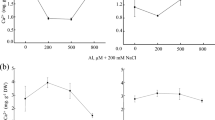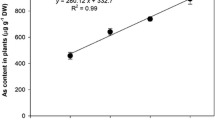Abstract
To investigate the extent of aluminum toxicity tolerance of eco-friendly, fast-growing, fresh water, pteridophytic Azolla–Anabaena symbiotic association in terms of altered physiological signals; Azolla microphylla Kaulf was exposed to 0 (control), 100, 250, 500, and 750 μM AlCl3, at pH 4.5 for 6 days. The adversity of Al was increased in a dose-dependent manner and the highest was recorded at 750 μM AlCl3. Despite the significant loss in membrane integrity (80% electrolyte leakage) due to an enhanced generation of H2O2, A. microphylla reflected only 50% growth inhibition (fresh and dry weight) at 500 μM AlCl3 (LD50). However, the average root length of Azolla was drastically reduced at high concentration due to their direct contact with aluminum-containing growth medium. Contrary to this, the whole association maintained moderate chlorophyll, carbohydrate content, photosynthetic efficiency, nitrogen-fixing ability, and nitrogen content at high Al concentration. Probably, growth protection was pertained through significant detoxification of H2O2 by employing an efficient antioxidative defense system including antioxidative enzymes (SOD, APX, and CAT) and non-enzymatic antioxidant carotenoids. An enhanced level of phenolics and flavonoids in the root exudates possibly maintained a non-toxic level of aluminum inside the cell (195.8 μg Al/g FW) which makes A. microphylla a suitable pteridophytic plant to not only remove toxic Al from the contaminated sites but also to improve nitrogen status of those regions.

ᅟ






Similar content being viewed by others
References
Achary VM, Jena S, Panda KK, Panda BB (2008) Aluminium induced oxidative stress and DNA damage in root cells of Allium cepa L. Ecotoxicol Environ Saf 70:300–310
Adamec F, Kaftan D, Nedbal L (2005) Stress induced filament fragmentation of Calothrix elenkinii (cyanobacteria) is facilitated by death of high-fluorescence cells. J Phycol 41:835–839
Aebi HE (1983) Catalase. In: Bergmeyer HU (ed) Methods of enzymatic analysis. Verlag Chemie, Weinhern, pp 273–286
Ahn SJ, Matsumoto H (2006) The role of the plasma membrane in the response of plant roots to aluminum toxicity. Plant Signal Behav 1:37–45
Aly Z, Graulet A, Scales N, Tracey TL (2014) Removal of aluminium from aqueous solutions using PAN-based adsorbents: characterisation, kinetics, equilibrium and thermodynamic studies. Environ Sci Pollut Res 21:3972–3986
Aono M, Sagi H, Fujiyama K, Sugita M, Kondo N, Tanaka K (1995) Decrease in the activity of glutathione reductase enhances paraquat sensitivity in transgenic Nicotiana tabacum. Plant Physiol 107:645–648
Arnon DI (1949) Copper enzymes in isolated chloroplasts. Polyphenoloxidase in Beta vulgaris. Plant Physiol 24:1–15
Asada K (2006) Production and scavenging of reactive oxygen species in chloroplasts and their functions. Plant Physiol 41:391–396
Awasthi JP, Saha B, Regon P, Sahoo S, Chowra U, Pradhan A, Roy A, Panda SK (2017) Morpho-physiological analysis of tolerance to aluminum toxicity in rice varieties of North East India. PLoS One 12(4):e0176357
Bennicelli R, Stępniewska Z, Banach A, Szajnocha K, Ostrowski J (2004) The ability of Azolla caroliniana to remove heavy metals (Hg(II), Cr(III), Cr(VI)) from municipal waste water. Chemosphere 55:141–146
Bojórquez-Quintal E, Escalante-Magaña C, Echevarría-Machado I, Martínez-Estévez M (2017) Aluminum, a friend or foe of higher plants in acid soils. Front Plant Sci 8:1767
Boscolo PRS, Menossi M, Jorge RA (2003) Aluminium-induced oxidative stress in maize. Phytochemistry 62:181–189
Cao H, Wang J, Dong X, Han Y, Ma Q, Ding Y, Zhao F, Zhang J, Chen H, Xu Q, Xu J, Deng X (2015) Carotenoid accumulation affects redox status, starch metabolism, and flavonoid/anthocyanin accumulation in citrus. BMC Plant Biol 15:27
Dionisio-Sese ML, Tobita S (1998) Antioxidant responses of rice seedlings to salinity stress. Plant Sci 135:1–9
Gensemer RW, Playle RC (1999) The bioavailability and toxicity of aluminum in aquatic environments. Crit Rev Environ Sci Technol 29:315–450
Grevenstuk T, Romano A (2013) Aluminium speciation and internal detoxification mechanisms in plants: where do we stand? Metallomics 5(12):1584–94
Heath RI, Packer I (1968) Photoperoxidation in isolated chloroplasts: I. Kinetic and stoichiometry of fatty acid peroxidation. Arch Biochem Biophys 125:89–198
Ibrahim MH, Jaafar HZE (2011) The influence of carbohydrate, protein and phenylalanine ammonia lyase on up-regulation of production of secondary metabolites (Total phenolics and flavonoid) in Labisia pumila (Blume) fern-vill (Kacip Fatimah) under high CO2 and different nitrogen levels. Molecules 16:4172–4190
Ibrahim MH, Jaafar HZE, Karimi E, Ghasemzadeh A (2012) Primary, secondary metabolites, photosynthetic capacity and antioxidant activity of the Malaysian herb Kacip Fatimah (Labisia Pumila Benth) exposed to potassium fertilization under greenhouse conditions. Int J Mol Sci 13:15321–15342
Jolly S, Jaffal A, Delahaut L, Palluel O, Porcher J-M, Geffard A, Sanchez W, Betoulle S (2014) Effects of aluminium and bacterial lipopolysaccharide on oxidative stress and immune parameters in roach, Rutilus rutilus L. Environ Sci Pollut Res 21:13103–13117
Kidd PS, Llugany M, Poschenrieder C, Gunse B, Barcelo J (2001) The role of root exudates in aluminium resistance and silicon-induced amelioration of aluminium toxicity in three varieties of maize (Zea mays L.). J Exp Bot 52:1339–1352
Kisnieriené V, Lapeikaité I (2015) When chemistry meets biology: the case of aluminium- a review. Chemija 26:148–158
Kollah B, Patra AK, Mohanty SR (2016) Aquatic microphylla Azolla: a perspective paradigm for sustainable agriculture, environment and global climate change. Environ Sci Pollut Res 23:4358–4369
Kovačević J (2010) Carotenoids as accessory and protective pigments in photosynthesis. Doctoral dissertation, Prirodoslovno-matematički fakultet, Sveučilište u Zagrebu
Leopoldini M, Russo N, Chiodo S, Toscano M (2006) Iron chelation by the powerful antioxidant flavonoid quercetin. J Agric Food Chem 54:6343–6351
Loreto F, Velikova V (2001) Isoprene produced by leaves protects the photosynthetic apparatus against zone damage, quenches ozone products, and reduces lipid peroxidation of cellular membranes. Plant Physiol 127:1781–1787
Lowry OH, Rosenbrough NJ, Farr AL, Randall RJ (1951) Protein measurement with the folin-phenol reagent. J Biol Chem 193:265–275
Mackinney G (1941) Absorption of light by chlorophyll solutions. J Biol Chem 140:315–322
Minocha R, Minocha SC, Long SL, Shortle WC (1992) Effects of aluminum on DNA synthesis, cellular polyamines, polyamine biosynthetic enzymes and inorganic ions in cell suspension cultures of a woody plant, Catharanthus roseus. Physiol Plant 85:417–424
Mira L, Fernandez MT, Santos M, Rocha R, Florêncio MH, Jennings KR (2009) Interactions of flavonoids with iron and copper ions: a mechanism for their antioxidant activity. Free Radic Res 36:1199–1208
Mishra AK (2003) Fox- and Fix- mutants of Anabaena 7120 defective in heterocyst development and nitrogen fixation. Algol Stud 108:75–85
Mishra AK, Singh SS (2006) Protection against salt toxicity in Azolla pinnata-Anabaena azollae symbiotic association by using combined N-sources. Acta Biol Hung 57:355–365
Mossor-Pietraszewska T (2001) Effect of aluminium on plant growth and metabolism. Acta Biochim Pol 48(3):673–686
Nakano Y, Asad K (1981) Hydrogen peroxide is scavenged by ascorbate specific peroxidase in spinach chloroplast. Plant Cell Physiol 22:867–880
Okuda T, Nishijima W, Sugimoto M, Saka N, Nakai S, Tanabe K, Ito J, Takenaka K, Okada M (2014) Removal of coagulant aluminum from water treatment residuals by acid. Water Res 60:75–81
Panda SK, Matsumoto H (2007) Molecular physiology of aluminum toxicity and tolerance in plants. Bot Rev 73:326–347
Pereira LB, Mazzanti CMA, Gonçalves JF, Cargnelutti D, Tabaldi LA, Becker AG, Calgaroto NS, Farias JG, Battisti V, Bohrer D, Nicoloso FT, Morsch VM, Schetinger MR (2010) Aluminum-induced oxidative stress in cucumber. Plant Physiol Biochem 48:683–689
Peters GA, Mayne BC (1974) The Azolla, Anabaena azollae relationship. I. Initial characterization of the association. Plant Physiol 53:813–819
Pettersson A, Bergman B (1989) Effects of aluminum on ATP pools and utilization in the cyanobacterium Anabaena cylindrica - a model for the in vivo toxicity. Physiol Plant 76:527–534
Radić S, Babić M, Skobic D, Roje V, Kozlina B (2010) Ecotoxicological effects of aluminum and zinc on growth and antioxidants in Lemna minor L. Ecotoxicol Environ Saf 73:336–342
Ramel F, Mialoundama AS, Havaux M (2013) Nonenzymic carotenoid oxidation and photooxidative stress signalling in plants. J Exp Bot 64:799–805
Richards KD, Schott EJ, Sharma YK, Davis KR, Gardner RC (1998) Aluminum induces oxidative stress genes in Arabidopsis thaliana. Plant Physiol 116(1):409–418
Roberts AE, Boylen CW, Nierzwicki-Bauer SA (2014) Effects of lead accumulation on the Azolla caroliniana–Anabaena association. Ecotoxicol Environ Saf 102:100–104
Rocha JBT, Pereira ME, Emanuelli T, Christofari RS, Souza D (1995) Effects of methylmercury exposure during the second stage of rapid postnatal brain growth on delta-aminolevulinic acid dehydratase (ALA-D) activity in brain, liver, kidney and blood of suckling rats. Toxicology 100:27–37
Samac DA, Tesfaye M (2003) Plant improvement for tolerance to aluminium in acid soils—a review. Plant Cell Tissue Organ Cult 75:189–207
Shen R, Ma JF (2001) Distribution and mobility of aluminium in an Al-accumulating plant, Fagopyrum esculentum Moench. J Exp Bot 52:1683–1687
Shukla MK, Tripathi RD, Sharma N, Dwivedi S, Mishra S, Singh R, Shukla OP, Rai UN (2009) Responses of cyanobacteria Anabaena doliolum during nickel stress. J Environ Biol 30:871–876
Silva S (2012) Aluminium toxicity targets in plants. J. Bot. Vol. 2012, article ID 219462, 8pages
Singh S, Mishra AK (2014) Regulation of calcium ion and its effect on growth and developmental behavior in wild type and ntcA mutant of Anabaena sp. PCC 7120 under varied levels of CaCl2. Microbiology 83:235–246
Singh SS, Singh SK, Mishra AK (2008a) Regulation of Na+ ion by combined-N sources in Azolla pinnata–Anabaena azollae symbiotic association during salt toxicity. Ecotoxicol Environ Saf 69:32–38
Singh SS, Upadhyay RS, Mishra AK (2008b) Physiological interactions in Azolla- Anabaena system adapting to the salt stress. J Plant Interact 3:145–155
Singh S, Tripathi DK, Singh S, Sharma S, Dubey NK, Chauhan DK (2017) Toxicity of aluminium on various levels of plant cells and organism: a review. Environ Exp Bot 137:177–193
Sivaguru M, Baluska F, Volkmann D, Felle HH, Horst WJ (1999) Impacts of aluminum on the cytoskeleton of the maize root apex. Short-term effects on the distal part of the transition zone. Plant Physiol 119(3):1073–1082
Steiner F, Zoz T, Pinto AS Jr, Castagnara DD, Dranski JAL (2012) Effects of aluminum on plant growth and nutrient uptake in young physic nut plants. Semin Cienc Agrar 33:1779–1788
Stewart RRC, Bewley JD (1980) Lipid peroxidation associated with accelerated ageing of Soyabean axes. Plant Physiol 65:245–258
Stewart WDP, Fitzgerald GP, Burris RH (1968) Acetylene reduction by nitrogen-fixing blue-green algae. Arch Mikrobiol 62:336–348
Tabaldi LA, Cargnelutti D, Gonçalves JF, Pereira LB, Castro GY, Maldaner J, Rauber R, Rossato LV, Bisognin DA, Schetinger MR, Nicoloso FT (2009) Oxidative stress is an early symptom triggered by aluminum in Al-sensitive potato plantlets. Chemosphere 76:1402–1409
Tanaka R, Tanaka A (2007) Tetrapyrrole biosynthesis in higher plants. Annu Rev Plant Biol 58:321–346
Thayumanavan B, Sadasivam S (1984) Physicochemical basis for the preferential uses of certain rice varieties. Qual Plant Foods Hum Nutr 34:253–257
Valderrama A, Carvajal DE, Penailillo P, Tapia J (2016) Accumulation capacity of cadmium and copper and their effects on photosynthetic performance in Azolla filiculoides lam. Under induced rhizofiltration. Gayana Bot 73:283–291
Wagner GM (1997) Azolla: a review of its biology and utilization. Bot Rev 63:1–21
Willekens H, Inzé D, Van MM, Van CW (1995) Catalases in plant. Mol Breed 1:207–228
Xu FJ, Li G, Jin CW, Liu WJ, Zhang SS, Zhang YS, Lin XY (2012) Aluminum-induced changes in reactive oxygen species accumulation, lipid peroxidation and antioxidant capacity in wheat root tips. Biol Plantarum 56(1):89–96
Yamamoto Y, Kobayashi Y, Devi SR, Rikiishi S, Matsumoto H (2002) Aluminum toxicity is associated with mitochondrial dysfunction and the production of reactive oxygen species in plant cells. Plant Physiol 128:63–72
Zhang X, Lin AJ, Zhao FJ, Xu GZ, Duan GL, Zhu YG (2008) Arsenic accumulation by the aquatic fern Azolla: comparison of arsenate uptake, speciation and efflux by A. caroliniana and A. filiculoides. Environ Pollut 156:1149–1155
Zheng SJ (2010) Crop production on acidic soils: overcoming aluminium toxicity and phosphorus deficiency. Ann Bot 106(1):183–184
Acknowledgments
We are thankful to the Head, Department of Botany, Banaras Hindu University, Varanasi, India, for providing laboratory facilities.
Author information
Authors and Affiliations
Corresponding author
Additional information
Responsible editor: Elena Maestri
Publisher’s note
Springer Nature remains neutral with regard to jurisdictional claims in published maps and institutional affiliations.
Rights and permissions
About this article
Cite this article
Chakraborty, S., Mishra, A., Verma, E. et al. Physiological mechanisms of aluminum (Al) toxicity tolerance in nitrogen-fixing aquatic macrophyte Azolla microphylla Kaulf: phytoremediation, metabolic rearrangements, and antioxidative enzyme responses. Environ Sci Pollut Res 26, 9041–9054 (2019). https://doi.org/10.1007/s11356-019-04408-7
Received:
Accepted:
Published:
Issue Date:
DOI: https://doi.org/10.1007/s11356-019-04408-7




